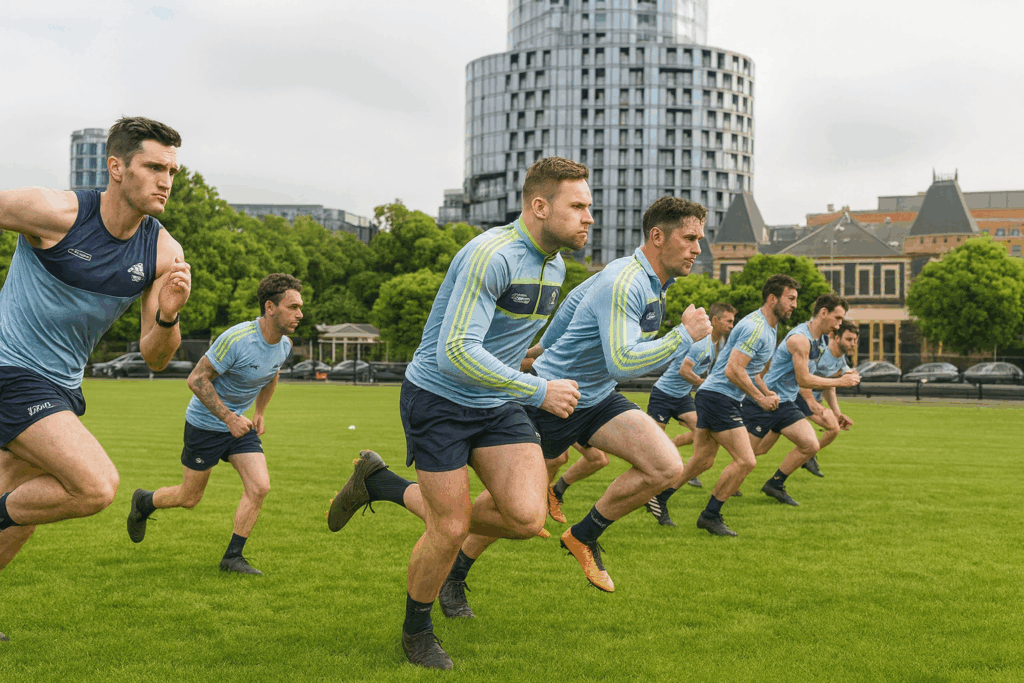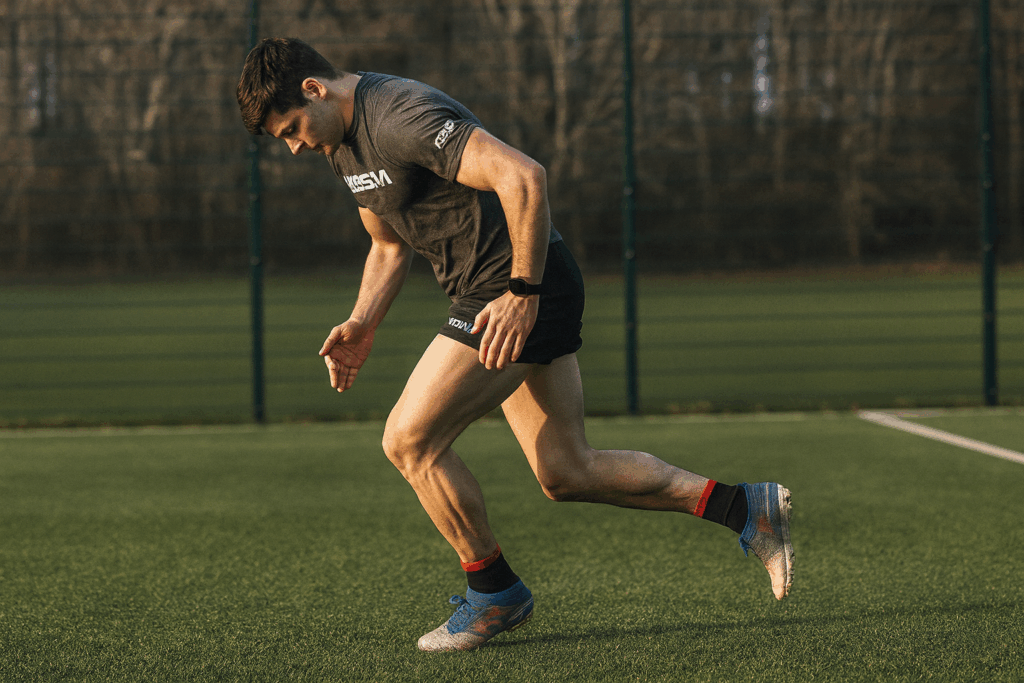Hamstring Injuries in Gaelic Football: Causes, Prevention, and Training Strategies
Introduction
Hamstring injuries are the most common and challenging injuries faced by Gaelic football players, significantly impacting player performance and team success. According to the National Gaelic Athletic Association (GAA) Injury Surveillance Database, hamstring injuries account for a substantial proportion of injuries among collegiate and inter-county players, with the incidence increasing by 45% between 2008 and 2016.
This guide explores the causes of hamstring injuries in Gaelic football, their prevalence during match play, and how to mitigate risks through targeted sprint training and injury prevention strategies.
The Prevalence of Hamstring Injuries in Gaelic Football
Key Statistics:
- Increased Risk in Matches: Players are seven times more likely to suffer hamstring injuries during games compared to training sessions.
- Sprinting as a Key Cause: Nearly three-quarters of hamstring injuries occur while sprinting, with most being non-contact in nature.
- Training vs. Match Load: Studies show that players cover significantly less distance and high-speed running during training (5417m total, 924m high speed) compared to matches (9222m total, 1596m high speed).
These findings highlight a critical gap: insufficient exposure to high-speed running in training may leave players underprepared for the demands of match play.
Why Sprinting Causes Hamstring Injuries
Sprinting places extreme demands on the hamstring muscles. As running speed increases, so does:
- Stress: The force applied to the hamstring muscles multiplies.
- Strain: Muscles stretch to their limits during the terminal swing phase of sprinting.
- Contraction Velocity: Rapid contractions increase the risk of muscle overload.
Without proper preparation, the hamstrings lack the capacity to handle these demands, leading to an elevated injury risk during match play.
Mitigating Hamstring Injuries Through Sprint Training
Key Principles:
- Expose Players to High-Speed Running:
- Gradual and progressive exposure to top-end sprinting helps build hamstring capacity.
- Sprint training directly replicates the demands placed on the hamstrings during matches, unlike gym exercises.
- Focus on Technique:
- Optimizing sprint mechanics can reduce unnecessary strain on the hamstrings.
- Incorporate drills that emphasize posture, rhythm, and relaxation.
- Balance Conditioning with Speed Work:
- While repeat sprint training is common, true speed training (95%+ effort with sufficient recovery) is often overlooked. This leaves players unprepared for the maximum-intensity sprints required during games.
Effective Sprint Training Strategies
1. Sprint-Specific Preparation
Before introducing high-speed running, ensure players have a strong foundation:
- Strength Training: Focus on exercises like Nordics, Romanian Deadlifts (RDLs), and glute bridges to strengthen the posterior chain.
- Dynamic Warm-Ups: Include drills like high knees, A-skips, and leg swings to prepare the hamstrings for explosive activity.
2. Gradual Exposure to High-Speed Running
Progressively increase sprinting intensity and distance over several weeks:
- Start with 70-80% of max effort sprints and gradually progress to 95%+ efforts.
- Incorporate flying sprints to develop top-end speed with controlled intensity.
3. Sprint Technique Optimization
Drills to improve sprint mechanics include:
- Wall Drills: Reinforce proper shin angles and knee drive.
- Resisted Sprints: Use sleds to build explosive acceleration mechanics.
- Wicket Drills: Improve stride length and rhythm at high speeds.
4. Integrate Speed and Conditioning
Combine speed and conditioning elements to mimic match scenarios:
- Small-Sided Games: Include sprint zones where players must reach 90-95% max speed.
- Reactive Drills: Use partner cues or agility lights to simulate game-specific sprint demands.
Sprint Training vs. Repeat Sprint Ability
It is essential to differentiate between speed training and repeat sprint training:
- Speed Training:
- Focuses on maximal effort sprints (95%+ intensity) with full recovery.
- Develops top-end speed and neuromuscular adaptations.
- Repeat Sprint Training:
- Involves shorter recovery periods and mimics the demands of match play.
- Primarily improves aerobic and anaerobic conditioning.
Insight for Coaches: Many Gaelic football players are underexposed to true speed training, leaving their hamstrings unprepared for the high-speed demands of matches. Incorporating speed-focused sessions ensures players build resilience and reduce injury risk.
Performance Benefits of Sprint Training
- Injury Prevention:
- Regular high-speed running conditions the hamstrings to tolerate match demands.
- Enhanced Match Performance:
- Research in soccer shows that straight sprinting is the most frequent action in goal-scoring situations. Similarly, in Gaelic football, speed is critical for breaking defensive lines and chasing opponents.
- Improved Efficiency:
- Better sprint mechanics reduce energy expenditure, allowing players to maintain speed longer during critical moments.
Practical Sprint Training Plan
Week 1-4: Foundations
- Focus: Build strength and introduce controlled sprints.
- Example Session:
- Warm-Up: Dynamic stretches, mobility drills.
- Acceleration: 5x20m sled sprints (light resistance).
- Sprint Mechanics: 3x40m flying sprints at 80% max effort.
- Cool-Down: Static stretches, foam rolling.
Week 5-8: Progressive Sprint Training
- Focus: Increase intensity and volume.
- Example Session:
- Warm-Up: High knees, A-skips, bounding drills.
- Max Velocity: 6x30m flying sprints at 95% max effort (full recovery).
- Reactive Agility: 4x10m reactive COD drills.
- Cool-Down: Mobility exercises, hamstring stretches.
Conclusion
Hamstring injuries are trending upward in Gaelic football, with sprinting identified as the primary risk factor. Players are often underprepared for the high-speed demands of match play due to insufficient exposure during training. Sprinting itself is the most effective exercise for building hamstring capacity and reducing injury risk, but it must be implemented progressively and with proper technique.
By integrating targeted sprint training, optimizing mechanics, and balancing speed with conditioning, coaches can significantly reduce hamstring injury rates while enhancing player performance on the pitch. Start incorporating these strategies today to protect your players and elevate their game.





